
How to create a complete digital marketing strategy for small businesses

A digital marketing strategy helps you to expand your reach by engaging with your audience online.
And given that there is a consistent increase in digital marketing budgets year over year, with a steady decline in traditional marketing spending, it’s clear that marketing on digital channels is a powerful way to convert leads and increase sales.
In this guide, we’ll explain how to put together a complete digital marketing plan and why each digital campaign you create should align with the stage of the marketing funnel your potential customer is in. We’ll also outline a few core digital marketing channels you can get started with today.
Table of contents
- Creating your digital marketing plan
- The marketing funnel
- 5 marketing channels to get you started
- Wrapping up
Creating your digital marketing plan
The goal of a marketing strategy is to document how your strategic business objectives will be achieved through different marketing approaches, channels and tactics.
This means that you can’t create a clear digital marketing plan without a business strategy that informs it. Before putting pen to paper, devise clear strategies and objectives for at least 6 to 12 months out. Once that’s complete, feel free to build upon your roadmap for the next 12 months to five years to achieve prolonged outlook.
Some basic business objectives include:
- A certain number of customers
- A specific revenue goal
- Staying cash flow positive
- Entering new markets
- Remaining relevant across all applicable markets
Your digital marketing plan will help you achieve the objectives you’ve set for your business, and more specifically your online marketing goals. Now, it’s time to determine exactly how you will reach those targets.
Top Tip: Your digital marketing strategy will help you to boost brand awareness. But before you put any effort into creating digital marketing campaigns, it’s critical that you’ve established a brand identity that resonates with your target audience and builds loyalty. To learn more about how to do just that, read our 7-step-guide to building a brand that customers love 😍.


Objective analysis
A great goal-oriented exercise helps you set actionable, measurable goals. A popular framework is the SWOT analysis, which stands for:
- Strengths. What unique advantages does your business have? What can you do better than the competition?
- Weaknesses. What can you improve, or which areas of the market should you avoid?
- Opportunities. Which market trends can you take advantage of?
- Threats: What are your competitors doing and which obstacles will you face?
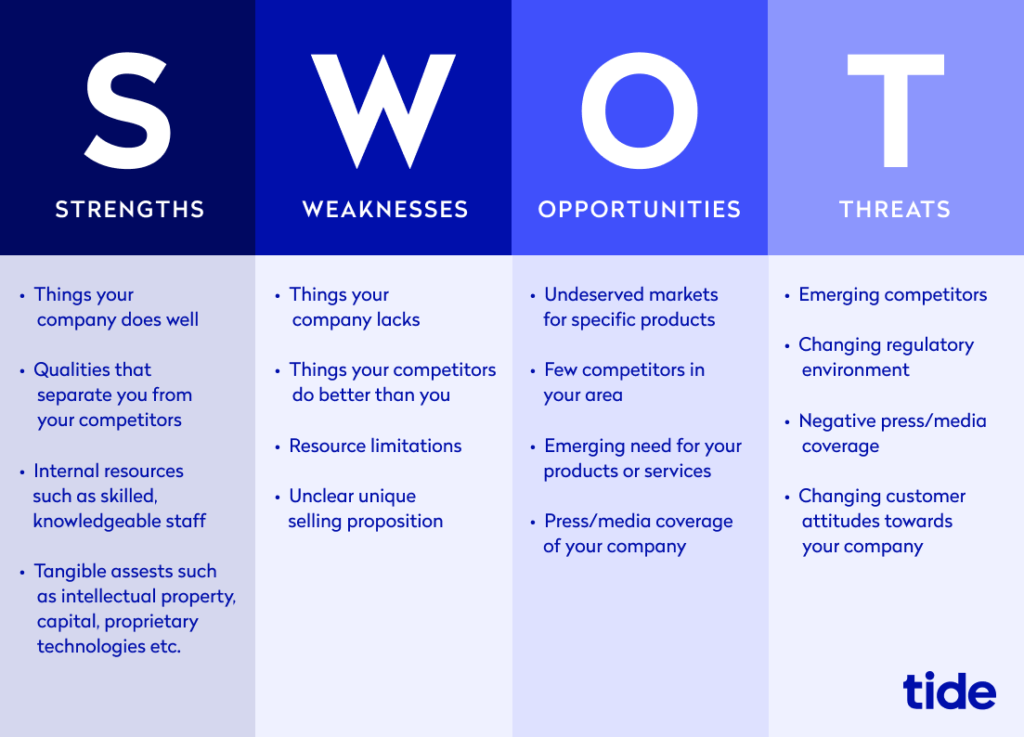
As a small business owner, having this level of awareness will make you more resourceful when planning your growth and marketing activities.
For example, if one of your strengths is proprietary knowledge within your industry, you can use this to fuel original and value-driven content to attract your target audience.
Establishing specific goals
You can then start setting practical digital marketing goals for your plan. It’s usually wise to set yourself SMART goals, which stands for:
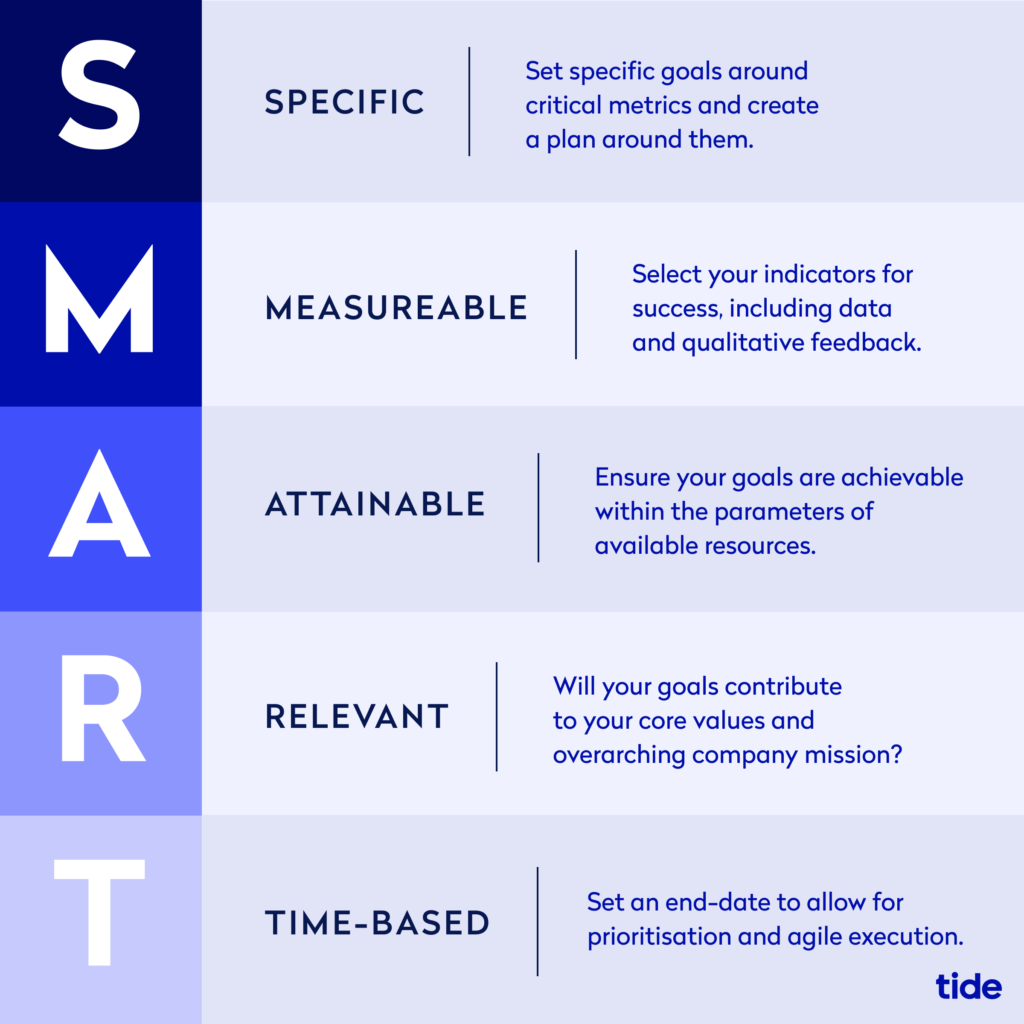
- Specific. This can be something as simple as new customers or total sales
- Measurable. Attach a tangible number you’ll be able to keep track of and report on
- Attainable. Your goal needs to be realistic. Base this on past business performance, or industry benchmarks
- Relevant. Your marketing goals must align with your core business goals (see above)
- Timely. When are you aiming to achieve this goal? Next quarter? Over the next 12 months?
A bad goal might be “increasing the number of followers to my Instagram account”. This isn’t specific or measurable.
A SMART way to rewrite this goal would be more like “We want to generate 5,000 new Intstagram followers over the next 12 months”.
Top Tip: Creating goals to increase followers on Instagram is wise, considering that Instagram has over a billion active users and 80% of them follow at least one of the 25 million active businesses on the platform. If you’re not on Instagram, you may be missing out on an opportunity to engage and build lasting relationships with your audience. To learn more about how to get started, read our beginner’s guide to Instagram marketing for small businesses 📸
Define a strategy
Following this approach you now have some well-defined goals that you can use to put your digital marketing plan together.
This involves documentation of three core areas:
- A definition of your target audience
- Your positioning in the market
- How you’ll communicate with your audience at each stage of the funnel
We’ll tackle the marketing funnel in the next section. For now, let’s start with the segment of the market you’re addressing, i.e., your target audience.
Segment your target audience
Your target audience can be defined by a series of attributes, some of which include demographics like:
- Age
- Sex
- Marital status
- Income
- Geo location
As well as more granular attributes (also known as psychographics):
- Celebrities or influencers they follow
- Publications they read
- Their interests and buying habits
Having a clearly-defined overview of your customers will make planning your digital marketing much easier. Some of this information you may already know, but the best way to collect it is by asking it from your customers directly. You can either do this through online surveys (using a tool like SurveyMonkey or Typeform) or speaking with them directly (either in-person or over the phone):
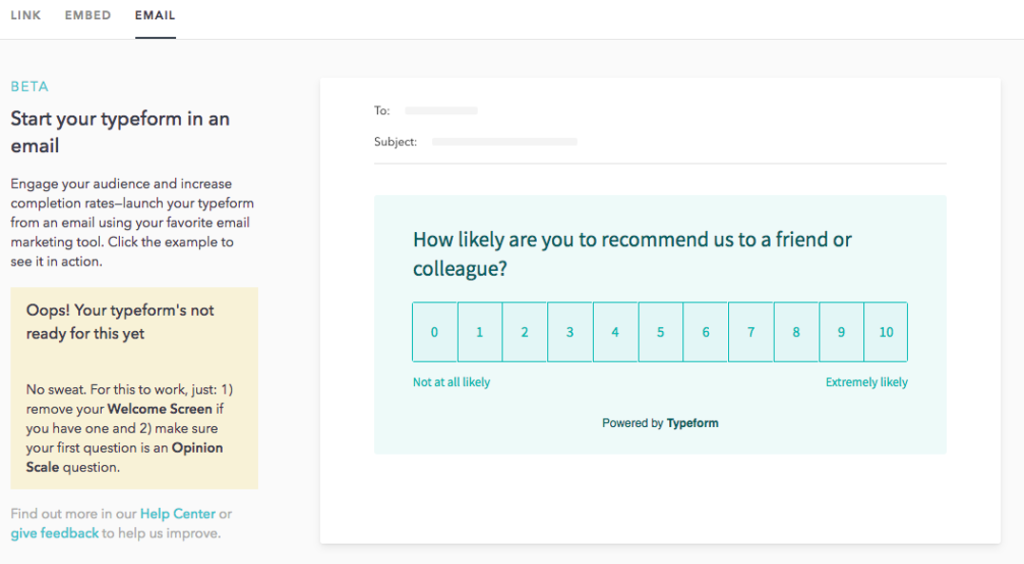
Building customer personas
You can then use this information to build your customer personas. These are documented “avatars” that represent your company’s ideal target audience.
These personas are based on the real target audience research you conducted and often help to keep your business partners and employees on the same page about targeted marketing efforts:
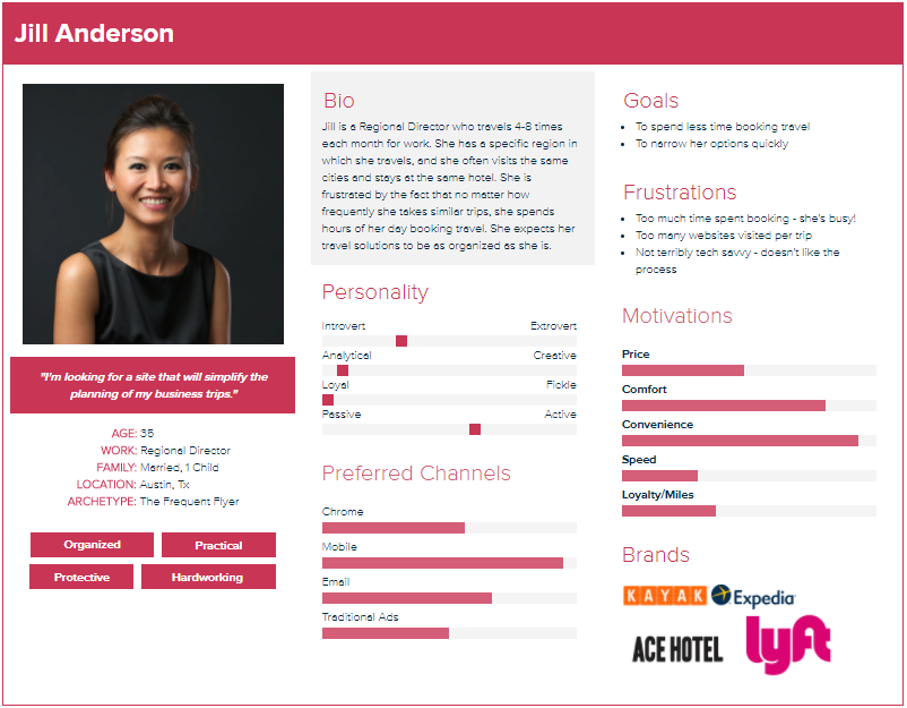
It’s common to have multiple customer personas that vary based on your diversified products and services. In fact, varying personas help you market to specific demographics for relevant items rather than attempting to market an aggregate product or service to a divided audience.
Top Tip: After you build your customer personas, you need to map your customer journey to create positive experiences and define your unique selling point (USP) so that you can separate yourself from the crowd. We’ve gone into detail how to successfully generate interest and close sales in our 5-step-guide to building an effective go-to-market (GTM) strategy 💯.
Studying your competition
Your SWOT analysis from earlier helps you to assess your overall strengths and weaknesses. But, unless you’re choosing an incredibly niche arena, your chosen market is most likely saturated with competition. And as much as you understand your goals, you need to better understand your competitor’s positions.
This requires having a strong understanding of your competitors and their own positioning in the market.
Understanding your competition’s achievements, pitfalls, target audience, marketing strategy, and so on helps you learn what strategies to mimic and what mistakes to avoid.
One of the fastest ways to do this is by searching for your competitors on social media and seeing what their audiences have to say about them.
Here’s an example tweet when we search The Trainline:

From this one engagement, we can see this customer values the quality of service received, presumably while being in a difficult or stressful situation. Given the positive feedback we can assume The Trainline’s customer service handled the unfortunate situation brilliantly.
To get the bigger picture, you’ll need to monitor the broader conversation – including any negative feedback they receive.
To help you get started, we’ve created a competitor analysis matrix spreadsheet with examples that you can glean insights from. Download it here for free and use it to record your detailed findings, stay organised and easily identify patterns.
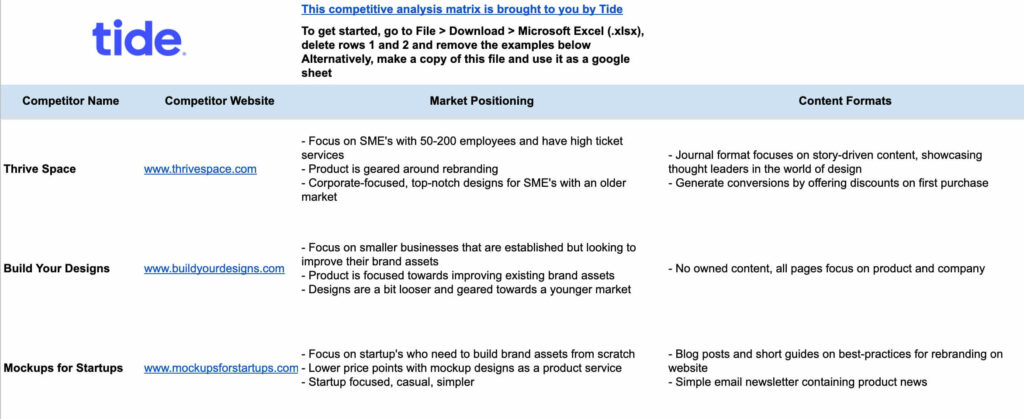
Top Tip: Understanding key information about your target market, like who your target audience and competitors are, the market size, pricing (which will help you figure out how to price your own products), and more, will help you position your messaging in a more effective and engaging way. To learn more about why market research is valuable and the various types of market research, read our detailed guide to how to conduct market research for your business idea 💭.
Market positioning
Now that you have a clear understanding of the space you occupy in the market, you need to position yourself in a way that makes you stand out. Customers should look at you and immediately understand why and how you differ from the crowd.
It’s time to create a positioning statement. This is a method of telling yourself, your team and the world what your values are, what you’re doing, how you’re doing it and most importantly, why you’re doing it. This can simply be written out as a mission, vision and values statement.
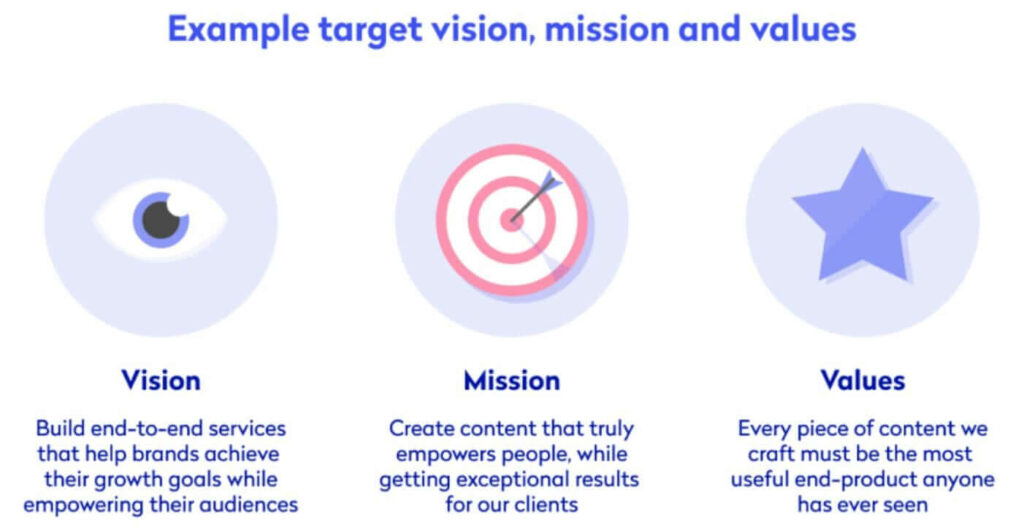
As another example, Tesla’s mission statement is simply: “To accelerate the world’s transition to sustainable energy”.
And their vision statement is: “To create the most compelling car company of the 21st century by driving the world’s transition to electric vehicles”.
There’s nothing too fancy going on here. All Tesla has done is create a short statement that sets the intention for their positioning.
Determining costs based on specific goals
Finally, with your digital marketing plan defined and in place, you’ll need to measure your results against your goals. Every single marketing activity should be measured against the goals you set in this section, and the metrics you should use to do this include:
- Return on investment (ROI). Possibly the most important metric, you should always strive for a positive ROI for every marketing activity.
- Cost per lead. The cost of generating a new lead into your marketing funnel (segmented by channel).
- Cost per sale. The cost of generating a sale (segmented by channel)
- Conversion rate. The number of people who click your ad, visit your website etc. that takes a specific action (download eBook, sign up for a free trial etc.).
- Customer lifetime value (CLTV). This is calculated by the average sale per customer multiplied by the average number of times they buy across a year. This one is particularly useful for measuring long-term ROI of your marketing efforts.
The marketing funnel
You now understand your competitors, as well as how your business will fit into the market. The next step is gaining a clear idea of how exactly your target audience will find your product or service and what drives them to make a purchase decision.
You can do this by exploring the marketing funnel. This is a method to map your marketing activity to your prospective and existing customers’ typical customer journey. It helps you develop a clear picture of what your customers go through when engaging and buying from your brand.
The more aware you are of your customer journeys, the more efficient your marketing efforts will be.
Each step of the marketing funnel is dedicated to making your audience more familiar with your brand. It also helps to build trust – a fundamental part of any relationship, and one that helps your customers feel more self-assured when engaging with your brand.
The modern marketing funnel is built of five stages:
- Awareness
- Consideration
- Conversions
- Loyalty
- Advocacy

As your customers’ needs change, your marketing efforts should adjust accordingly. It’s best-practice to continually return to the marketing funnel and revise your marketing strategy, need be, to remain relevant and engaging within your target audience.
Let’s run through each step of the marketing funnel in detail.
1. The awareness phase
The awareness phase is where you draw in potential customers who are not yet familiar with your brand and its products or services.
Think of this as a lead generation strategy where you cast a wide net and see who bites. Your ‘net’, so to speak, can take many forms, with all efforts leading towards the common goal of showcasing your brand to a wide audience and attempting to build trust.
As touched on above, building trust is a fundamental part of gaining new customers. It helps them ease into the idea of buying from you. After all, anybody who shells out money for a product or service can’t ever be sure they will get their money’s worth.
The awareness phase is about showing potential customers your brand is worth every penny.
So, how do you cast this net and build trust? Here are a few ideas to help you get started:
- Create content that adds value. his can take the form of engaging blog posts, infographics, white papers, e-books, and more. Of course, skew this content towards your target audience and make sure to include captivating call-to-actions (CTAs) throughout to influence your readers to click to learn more, sign up, or make a purchase.
- Host a webinar. Use webinars to teach your target audience about your brand and answer questions upfront and honestly. This is a great forum to connect in real time with potential and existing customers and learn from their desired or current experiences. You may walk away with a great new way to reach even more people.
- Run a targeted campaign. Target a campaign at people who fit into your fictional buyer persona’s so that you are reaching specific demographics with intention. Find out where they spend their time online and then run the campaign across many social networks, like Facebook, Instagram and LinkedIn, for maximum targeted reach. Untargeted efforts will produce a disappointing amount of results. Not to mention they will waste money.
You can also use direct mail, social media posts, networking events and trade shows to put yourself out in front of your target audience. Hopefully, they will find your efforts educational, entertaining and ultimately valuable.
2. The consideration phase
Once you’ve generated leads through the awareness phase, it’s time to teach them more about your company.
Use this phase as an opportunity for your potential customers to learn as much as they can about your products and services. Find out their pain points and show them how your business will help to solve them.
You want to show potential customers your best side while also being transparent about how your business operates.
This is also the phase to nurture your leads through targeted content that shows off why and how your products and services will provide value. It’s a chance to go a bit deeper below the surface.
If you’re already up and running, a great way to do this is by not just talking about how your business has solved other people’s problems, but showing exactly how they have. Use case studies, testimonials or reviews. Your job here is to help guide the prospect further down the funnel.
3. The conversion
At this stage, your leads are getting warmed up to the idea of actually spending money at your business. This is when they turn from leads into prospects.
Qualified prospects often fall into your target market, have the means to move forward with the deal and are authorised to do so. If you were talking with a project manager, for example, now is most likely when you will be introduced to their manager who has purchasing power.
Continue to nurture them through the funnel with targeted campaigns and case studies to keep interest high. Now is also a great time to discuss discounts and bundled deals. Show them how much they’ll save in year 1 if they sign up by X date. Gauge your customer and if you feel you can create a bit of urgency to finalise faster, go for it.
You can also position yourself against your competitors (or let your audience do it for you), like this YouTube video where Robin James compares Harry’s razors with Gillette’s:
The key is to convert them without jeopardising trust. Ideally, they are as excited to buy as you are to sell.
4. Fostering loyalty
Once you’ve converted a prospect into a customer, you need to keep them. This is where customer retention comes into play.
The obvious retention pattern is repeat purchases of the same item. If you sell services with subscriptions, however, the retention is renewing when the subscription expires or levelling-up to a higher price point with more perks and benefits. If you sell products, cross-selling is a fantastic way to encourage customers to experience more of your offers.
This is an often overlooked part of the digital strategy, with much of the focus being placed on acquiring rather than retaining.
However, acquiring a new customer can cost five times more than the cost of retaining one. And, if you focus on retaining 5% more customers, your profits can increase by 25%-95%.
Those numbers tell us that retaining existing customers is incredibly important and deserves the time and personalisation it takes to give them extra attention and keep them happy.
Plus, you’ve already done the hard work, so aim to keep that existing relationship strong.
Some tips for retaining customers are:
- Creating videos on how they can benefit from new products or services
- Sending exclusive offers for future purchases (e.g. 20% off your next order)
- Customer satisfaction surveys to see how happy buyers are with their new purchase
Don’t forget about customer service. One unhappy customer can lead to a massive headache. Make sure you maintain quick response times, listen to your customer’s needs, provide a warranty to take the hit if something with your product or service malfunctions, and be empathetic.
5. Turning customers into advocates
The final stage of the funnel focuses on turning customers into advocates.
Happy customers are also a great form of free marketing. Statistics show that one happy customer tells nine of their friends about their positive experience. By keeping one customer happy, you’ve just potentially gained nine.
Brands who successfully foster strong relationships with their customers do so because they take the time to listen to their needs. Customers who feel heard will go the extra mile for your business through word-of-mouth marketing.
Before you know it, you’ll have dozens if not hundreds of free brand ambassadors talking up your business and generating new prospects and leads.
Lululemon do a great job of this, offering their ambassadors a space to run yoga classes, as well as other benefits to empower them to spread Lululemon’s mission:

Talk to your best customers on a regular basis. Ask them what their biggest goals are, and how you can help them achieve them. This is how you show you care.
Five marketing channels to get you started
Each stage of the funnel serves a purpose for business growth – both from a customer acquisition and loyalty perspective.
Putting together a digital marketing plan that maps out the customer journey will help you to aim in the right direction. But how exactly do you do this?
Let’s cover five digital marketing channels and approaches you can get started with today.
Channel #1: Social media marketing
Social media has become a staple of day-to-day life. Your customers are using it, and there’s no doubt about it: your brand needs to be there, too.
The first step to successfully using social media to promote your business is to focus on one or two channels. Figure out which ones your customers use the most and double down on them.
Why only one or two? Because when you spread yourself across more, it’s hard to commit to the process with the intent it requires.
Not sure how to find the platforms your customers are using? Check out where your competitor’s have the strongest followings and see if you can capitalise in the same space.
You can also approach it from a platform standpoint rather than your customer’s POV. Do you research around each platform’s demographics and adoption and choose the ones that fall in line with your target market.
Once you choose your social media outreach platforms, start off by creating great content that your customers will want to engage with. If you can, interact with your customers by replying to their comments and questions.
A great example of a client who creates content that performs well on social media platforms is travel brand Huckberry. They know their audience loves travelling and respond well to travel photography. Therefore, they create high-quality content of this nature to attract and engage with their followers:
They also bake this approach into their consideration and awareness content by uploading great looking photographs of their products in action:
They’ve created the perfect blend of value-driven and promotional content to cover all stages of the funnel.
Pay attention to what your customers respond well to. Is it high-quality photography, videos or illustrations? Then, establish a cadence that delivers this content and create a social media voice that they’ll look forward to seeing.
If you can only create two posts on each platform a week, then commit to that and no more (until you can automate or outsource parts of the process).
Top Tip: More than half of the 97% of digital consumers that have used social media in the past month used it to search for products. Posting on social media is so much more than simply a space to expand your audience. It allows businesses a cost-effective approach to increasing engagement and converting leads into customers. To learn more about how to engage the right people, on the right channels, at the right time, read our guide to how to create a social media marketing strategy for your small business📱.
Channel #2: Content marketing
Seth Godin, an entrepreneur, best-selling author and authoritative voice in the marketing space, once said that “content marketing is the only marketing that’s left.” This went with his belief that the only way to connect with an audience is by giving value first.
And this is the exact philosophy behind content marketing. A content strategy is where you deliver value to your audience through blog posts, e-books, videos and other formats to build a meaningful connection with them.
In truth, content can be applied to all channels and stages of the funnel, but it’s well worth addressing as a standalone approach.
For example, SaaS brand Buffer create blog posts around social media marketing trends, news and how-to tips:
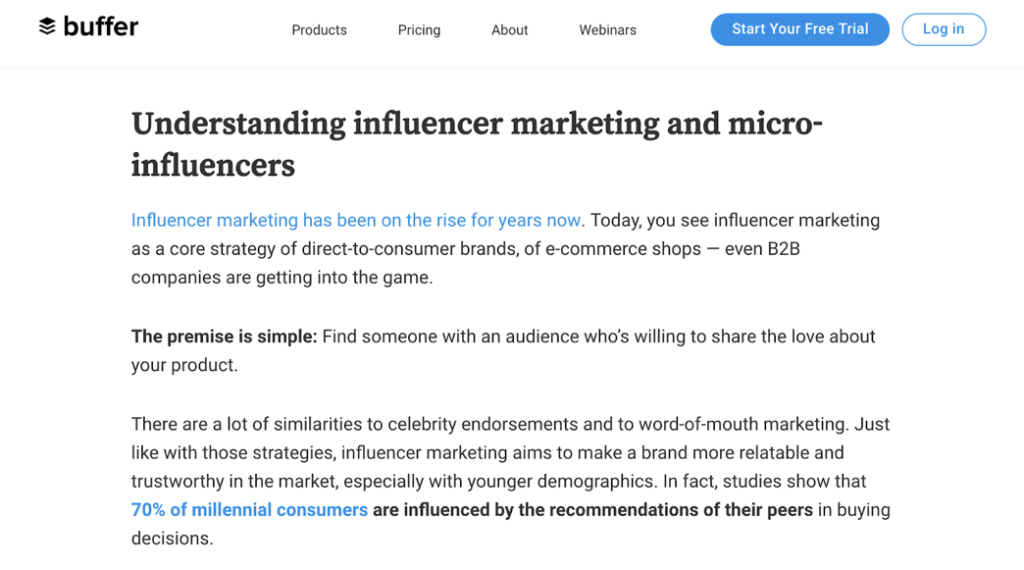
These blog posts can rank highly in Google (see channel #3 below) and connect with new prospects fast. They can also be used to help your customers use your products or services.
When coming up with topics to create content around, start with your customers. What are their product pain-points and non-product related pain-points? They should be relevant to your brand in some way (a furniture shop wouldn’t write about cooking, for example). But they don’t have to be all about your products.
Channel #3: SEO
Search Engine Optimisation is definitely a long term commitment, but it is also one of the more cost-efficient channels that can bring exponential growth.
There many things to consider with regards to an SEO strategy, and it would require a guide in itself to go through. But here’s a quick rundown of the basics:
- Getting your technical house in order. Technical SEO refers to how well the code behind your website is looked after. For example, if your website isn’t designed for mobile devices and loads slowly, this is a bad sign in Google’s eyes as this hinders the user experience of your website visitors. Make sure your website has good technical health, is coded well, works on mobile devices and loads quickly.
- Do your keyword research. Use a tool like Google’s Keyword Planner (GKP) to identify the right keywords to target. This tool (and others like Ubersuggest) will show you an estimate of how many people are searching for specific keywords, allowing you to choose which topics you target. It is important to not get stuck on individual words but have the broader subjects on your radar that your audience is interested in.
- Optimise your content. This is how relevant the content on your website is for your target keywords and topics and how well it relates to what your (potential) readers and customers search for online. Your on-page SEO can include product pages, landing pages and blog posts. Aim to be the go-to, most relevant, high-quality and authoritative source of information around the given subject.
- Get some off-page coverage. Whenever a website links back to one of your pages, this is considered a “vote.” The more backlinks you generate, typically, the more popular your page is considered, and therefore the higher it’s likely to rank. Quality over quantity is most important though. Any reference to you should come from a trustworthy site and a page that is also relevant to your content. Stay away from spammy websites and make sure your link count increases organically. Always remember links should not only be there for the sake of having a backlink. Rather, they should actually bring visitors to your site instead.
There’s a lot to take in here, so we suggest you have a more in-depth read. One well-known resource is Moz’s Free “Beginner’s Guide to SEO”. You can also have a look at reading material Google provides themselves such as the SEO Starter Guide.
Channel #4: Paid media
If you have the capital available, paid channels (like Google Ads and Facebook Ads) can be a fast way to attract new customers, test your messaging and generate a positive ROI.
The paid channels you choose will, again, depend on where your customers can be found. For example, you don’t want to spend money on Twitter Ads if your audience is highly active on Facebook. Start with where you know your audience is most active.
Most digital paid media platforms work on a cost-per-click (CPC) basis. This means that you pay every time a user clicks on your ad, which is based on a bidding system.
Let’s take Google’s pay-per-click (PPC) platform, Google Ads. You can set up campaigns that target specific keywords and drive them to relevant landing pages. For example, if you sell Colombian coffee beans, you can target people searching for the term “buy Colombian coffee beans”:
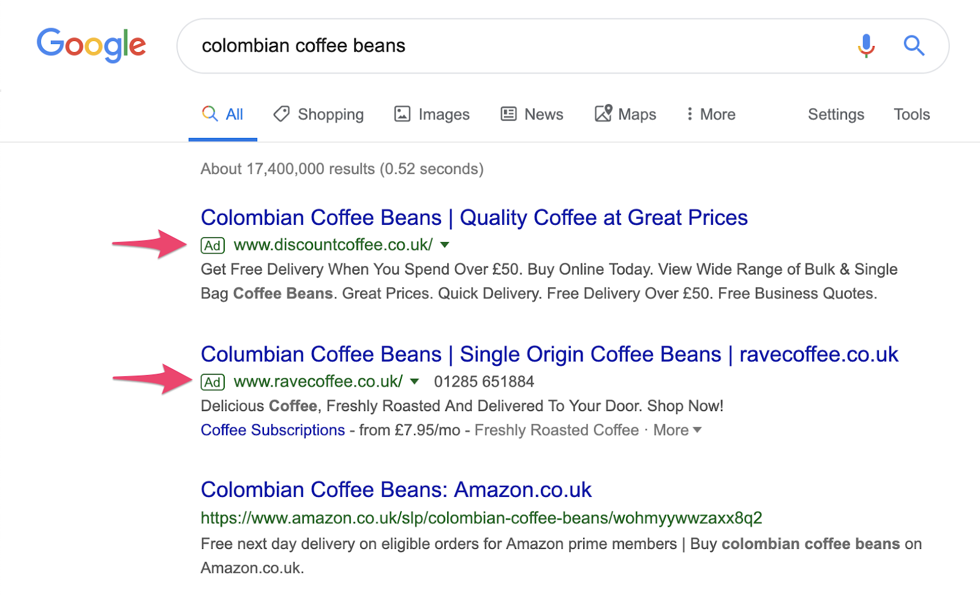
A similar system works on platforms like Facebook Ads and Instagram Ads. Instead of keywords, however, you target based on user interests. Taking our coffee example, you can serve your ads to users who are interested in other coffee related pages, or have expressed an interest in coffee-related topics.
Some quick tips for experimenting with paid media:
- Start with a small budget. It can be tempting to blow a big budget from the beginning. However, this can be a fast way to waste heaps of money. Start by testing on a small scale, and ramp up your efforts slowly as you see positive results.
- Use customer-driven messaging. Your paid ad copy must get their attention quickly. Do this by using language they’re familiar with and focus on their pain-points.
- Include an eye-catching image. If you’re advertising on social media, you must use an image that stops them in their tracks. People scroll through their news feeds quickly, so use imagery with bright and contrasting images.
- Understand each platform’s guidelines. Some platforms may have rules that prohibit certain items from being used in an ad. For example, the rules around alcohol and cryptocurrencies may vary by platform. Be aware of this before you commit to an ad campaign with content that’s banned.
Channel #5: Email marketing
Your email list of subscribers, leads and customers is one of the most valuable marketing assets you can build. While platforms like Facebook and Instagram essentially “own” your followers, you own your email list.
Which is why it should be the centrepiece of your marketing activity. As you collect email addresses from prospects at all stages of the funnel, it will be easier to guide them through the customer journey.
Here’s how this translates to the marketing funnel we laid out earlier:
- Awareness. Offer something of value in exchange for an email address, such as an ebook, webinar or other piece of content.
- Consideration. Here, you can send your prospects more content based on their interests and challenges. For example, a blog post that shows the pros and cons of your approach over others.
- Conversion. Send your prospects an offer or discount for your product, free trial or consultation (depending on pricing and complexity of your offer).
- Loyalty. Once customers buy from you, send them additional content that helps them get the most out of their products, as well as exclusive deals and offers.
- Advocacy. Reach out to your best customers and thank them for being a loyal customer. Consider inviting them to a referral program where they get rewarded for every new customer they bring on board.
You can get started with an affordable and simple tool like Mailchimp, which allows you to collect contact details through forms and send emails directly from their platform.
Here’s a strong email example from office startup Knotel, where they send prospects an invitation to a webinar that showcases how their business helps other businesses find the ideal office space.

Wrapping up
Building a strong digital marketing plan requires a strong understanding of the customer journey. How do your customers behave at each stage of the funnel?
Answering this question requires some research, but the key is to provide prospects with the right content and information to help them make a decision to buy from you.
Here’s a quick rundown of what your digital marketing strategy should include:
- Start with a SWOT analysis to figure out your strengths, weaknesses and advantages in the market
- Define SMART business goals and let this drive your marketing strategy
- Get a strong understanding of your target audience, their interests and where to find them
- Create a vision and mission statement, and establish your positioning in the market against your competitors
- Finally, create content across core channels that addresses each stage of the marketing funnel
From awareness to advocacy, aim to create great content and show your prospects that you’re the right product or service for their needs. This is how you create a brand that captures customers for life.


Learn all about growing your business in our marketing series:
Marketing Strategy
1.1 How to create a ‘Go To Market Strategy’ to tap into new markets
1.2 A beginners guide to digital marketing strategy
1.3 How to run a competitive analysis
1.4 How to build a brand that customers love
Marketing Ideas
2.1 8 affordable in-depth marketing ideas to grow your small business
2.2 30 ways to get clients as a freelancer
2.3 5 marketing metrics to maintain & measure small business growth
Marketing Channels
3.1 How to create a social media marketing strategy in 2020
3.2 The small business guide to Instagram marketing
3.3 How to build brand loyalty with relationship marketing
3.4 How to master business storytelling
3.5 How to grow your business with video (on a budget)
Photo by Lukas, published on Pexels




